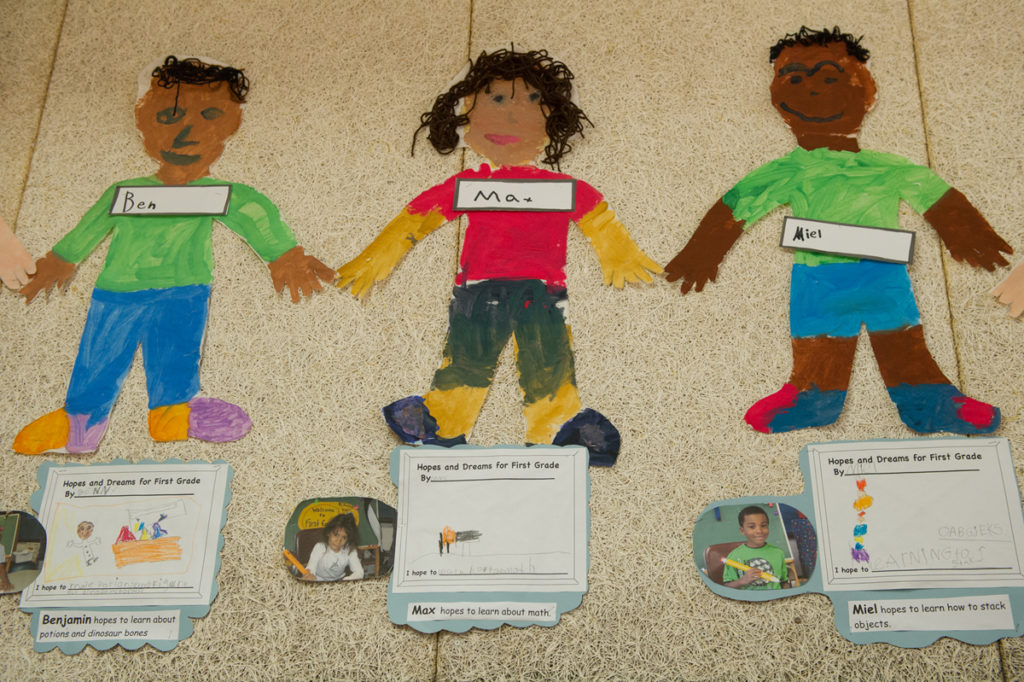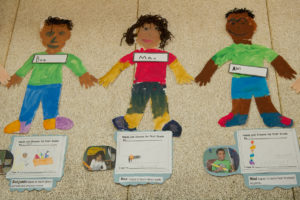
 A classroom filled with the work of children is a delight to be in and sends a message to students that their work and their learning are important. Although early in the school year, the teacher might do much of the display planning and caretaking, as the year progresses, students can take an increasingly active role in displaying their work. There are several ways in which children can be involved. They can simply choose pieces of their own work that they give to the teacher to assemble into a display. They can create the actual display by, for example, designing and putting together a bulletin board. And they can manage the entire process from choosing the work, to building the display, to providing ongoing maintenance.
A classroom filled with the work of children is a delight to be in and sends a message to students that their work and their learning are important. Although early in the school year, the teacher might do much of the display planning and caretaking, as the year progresses, students can take an increasingly active role in displaying their work. There are several ways in which children can be involved. They can simply choose pieces of their own work that they give to the teacher to assemble into a display. They can create the actual display by, for example, designing and putting together a bulletin board. And they can manage the entire process from choosing the work, to building the display, to providing ongoing maintenance.
In taking on responsibility for displays, students have an opportunity to learn and practice important social and academic skills. When children choose work for displays, they learn to reflect on their work. By creating displays that recognize effort rather than perfection, children better understand that learning is a process of growth, not just a process of mastery. Creating displays can also affirm children’s growing sense of competency and give them practice in individual and group decision-making. It provides an opportunity to learn from each other and to appreciate the work of others, nurturing empathy, respect, and a strong sense of classroom community.
Setting up a display allows children to develop their creativity and to practice skills of measuring, cutting, using tools, and writing. Maintaining displays gives an opportunity for children to develop organizational and decision making skills. All aspects of creating and maintaining displays allow children to take responsibility for an important part of the classroom life.
In order for children to feel comfortable choosing work for display, it’s important to teach them how to assess their work and how to make choices.
Begin by asking, “Why do we display work in our classroom?” Answers might include: “So we can see what each other is doing.” “So we can show work that we’re proud of.” “So we can learn more about a topic.” “So that we have interesting things on the walls.” The teacher might add that displays also help students reflect on their work, learn from each other’s work, and make the classroom beautiful.
Together, develop criteria for choosing work to display. These criteria might include:
Throughout the year, give children opportunities to use different criteria for choosing work that might be displayed. For example, as they look through their portfolio of writing that they’ve done so far this year, have them choose a piece of work that shows growth, a piece that shows hard work, a piece that shows teamwork, etc.
The first time students select a piece of their own work for actual display, ask them to share it with the class before putting it up. Students can point out one aspect of the piece that they would like the class to notice.
Effective displays celebrate each piece of work and radiate with a sense of student pride. They highlight the individual pieces of work rather than the surrounding decoration. Here are some ways you can help children learn to create effective displays:
With a clear understanding of these purposes, children will be able to make clear, thoughtful decisions about what to display and how to display it.
Take children to visit displays in the hallways and classrooms of the school. Consider also visiting “real world” displays such as those in museums, storefronts, or libraries. Invite children to examine the effectiveness of these displays.
Using information that the children have gathered from visiting various displays and the list of purposes of displays, create general guidelines for creating an effective display. For example:
Displays should be simple.
Displays should show what is most important in the work.
Decorations should fit with the piece of work and show it off.
Displays should include a label with the name of the student, the title of the work, and perhaps something about the work.
Displays should be neat.
Make sure that children always have easy access to the tools necessary for creating displays: a variety of art and writing materials, push pins, a stapler, and a staple remover. Include a supply of index cards and writing tools for creating labels.
After establishing the guidelines for effective displays, students are ready to learn techniques to make displays beautiful and attention getting. For example, students can make a simple frame by placing the work on top of another piece of paper that is slightly larger and of a contrasting or complementary color. Or, for a quick and economical frame, students can draw a straight line around the outside of the piece. Once the work is framed, encourage students to consider the many possibilities for hanging the work. They may want to hang pieces at different angles, in staggered steps, or in other interesting patterns. Or they might want to display the work against a backdrop, which can draw the viewer’s eye to the piece. One kind of backdrop is made from paper or fabric of a contrasting or complementary color, cut to a different size and shape and hung at an angle behind the displayed work.
Labels can be used to identify the theme of a display, identify the creators of the work, or capture the viewer’s attention. In addition to simple hand printed labels, students can use computer generated labels, photographs of the work’s creator, or labels that look like comic book bubbles.
Once children have learned how to choose work for displays and to display work effectively, they may be ready to take over the management of some of the display areas. By creating the role of a “student curator,” a teacher can move the responsibility for ongoing management of the displays to the students.
The curator can be an individual, a pair of students, or even a small group of children. Curators might have the responsibility for a week, a month, or for the duration of a particular display.
Following are some possible student curator responsibilities:
Keep the area neat and beautiful. The curator is responsible for making sure that nothing falls down, that corners are pinned flat, and that the display looks good in general.
Collect interactive work related to the display. For example, a display might invite students to ask questions about the work displayed. Students would put their questions in an envelope in the display area, and the curator would collect the questions daily. Children might later work in small groups to discuss and answer the questions.
Oversee the creation of a display. The curator makes sure that everyone responsible for setting up a display does her/his job. In upper grade classrooms the curator might be in charge of creating a “blueprint” for the display area based on the number of children displaying and the kinds of work to be displayed. The curator might also decide how many pieces of work an area can hold.
Decide on a theme. The curator chooses a particular theme for a display and manages the display area. Any student may then choose to participate in the theme display.
Organize a formal opening of the display. Once a display is complete, the curator may hold an organized sharing time. During this sharing, the children displaying work would talk about their pieces and take questions and comments. The “audience” would be invited to visit the display during the day, then talk with the displayers about their work at the end of the day. The curator structures and manages this “grand opening.”
Collaborative displays that celebrate students’ efforts and connect to the daily life of the classroom are one of the most powerful—and overlooked—tools for teaching. Working with children to build and maintain displays can generate excitement about the curriculum, increase children’s investment in learning, help children to appreciate their own work and the work of others, and foster individual and group ownership of the classroom.
This article is adapted from Classroom Spaces that Work, NEFC, 2001.
Displays should have a meaningful connection to the curriculum. They should be effective tools for teaching and learning. This is particularly important as the holiday season approaches. Although there’s nothing wrong with seasonal displays, the material on display should go beyond simply marking the holiday. Instead the information should connect with, emerge from, and expand students’ knowledge about topics being studied.
Create displays that honor effort and not just perfectly mastered work. Displays should make every child feel valued regardless of his or her academic or artistic abilities. Whenever possible, avoid using grades, stickers, or marks on children’s work, especially work that will be displayed.
Make sure there is always one display that reflects the efforts of everyone in the class. These displays affirm each child’s sense of belonging and have a powerful effect on creating community. For example, many classrooms have a permanent display of students’ “hopes and dreams” for the year.
Keep displays fresh, useful, and uncluttered. Make sure that the children’s work is changed often enough to keep the displays relevant to the curriculum and keep them from getting “stale.” With limited space it is better to regularly rotate the children’s work than to crowd and clutter the area.
Marlynn K. Clayton, author of Classroom Spaces That Work, has twenty years experience as a classroom teacher. She is a co-founder of Northeast Foundation for Children.